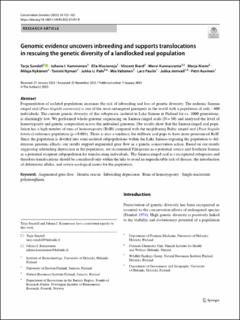| dc.contributor.author | Sundell, Tarja | |
| dc.contributor.author | Kammonen, Juhana I. | |
| dc.contributor.author | Mustanoja, Ella | |
| dc.contributor.author | Biard, Vincent | |
| dc.contributor.author | Kunnasranta, Mervi | |
| dc.contributor.author | Niemi, Marja | |
| dc.contributor.author | Nykänen, Milaja | |
| dc.contributor.author | Nyman, Tommi | |
| dc.contributor.author | Palo, Jukka U. | |
| dc.contributor.author | Valtonen, Mia | |
| dc.contributor.author | Paulin, Lars | |
| dc.contributor.author | Jernvall, Jukka | |
| dc.contributor.author | Auvinen, Petri | |
| dc.date.accessioned | 2023-09-27T12:07:44Z | |
| dc.date.available | 2023-09-27T12:07:44Z | |
| dc.date.created | 2023-03-29T10:38:58Z | |
| dc.date.issued | 2023-01-07 | |
| dc.identifier.citation | Conservation Genetics. 2023, 24 155-165. | en_US |
| dc.identifier.issn | 1566-0621 | |
| dc.identifier.uri | https://hdl.handle.net/11250/3092410 | |
| dc.description.abstract | Fragmentation of isolated populations increases the risk of inbreeding and loss of genetic diversity. The endemic Saimaa ringed seal (Pusa hispida saimensis) is one of the most endangered pinnipeds in the world with a population of only ~ 400 individuals. The current genetic diversity of this subspecies, isolated in Lake Saimaa in Finland for ca. 1000 generations, is alarmingly low. We performed whole-genome sequencing on Saimaa ringed seals (N = 30) and analyzed the level of homozygosity and genetic composition across the individual genomes. Our results show that the Saimaa ringed seal population has a high number of runs of homozygosity (RoH) compared with the neighboring Baltic ringed seal (Pusa hispida botnica) reference population (p < 0.001). There is also a tendency for stillborn seal pups to have more pronounced RoH. Since the population is divided into semi-isolated subpopulations within the Lake Saimaa exposing the population to deleterious genomic effects, our results support augmented gene flow as a genetic conservation action. Based on our results suggesting inbreeding depression in the population, we recommend Pihlajavesi as a potential source and Southern Saimaa as a potential recipient subpopulation for translocating individuals. The Saimaa ringed seal is a recognized subspecies and therefore translocations should be considered only within the lake to avoid an unpredictable risk of disease, the introduction of deleterious alleles, and severe ecological issues for the population. | en_US |
| dc.language.iso | eng | en_US |
| dc.publisher | Springer Nature | en_US |
| dc.rights | Navngivelse 4.0 Internasjonal | * |
| dc.rights.uri | http://creativecommons.org/licenses/by/4.0/deed.no | * |
| dc.title | Genomic evidence uncovers inbreeding and supports translocations in rescuing the genetic diversity of a landlocked seal population | en_US |
| dc.title.alternative | Genomic evidence uncovers inbreeding and supports translocations in rescuing the genetic diversity of a landlocked seal population | en_US |
| dc.type | Peer reviewed | en_US |
| dc.type | Journal article | en_US |
| dc.description.version | publishedVersion | en_US |
| dc.rights.holder | © The Author(s) 2023 | en_US |
| dc.source.pagenumber | 155-165 | en_US |
| dc.source.volume | 24 | en_US |
| dc.source.journal | Conservation Genetics | en_US |
| dc.identifier.doi | 10.1007/s10592-022-01497-9 | |
| dc.identifier.cristin | 2137978 | |
| dc.relation.project | EU/000832 | en_US |
| cristin.ispublished | true | |
| cristin.fulltext | original | |
| cristin.fulltext | original | |
| cristin.qualitycode | 1 | |

